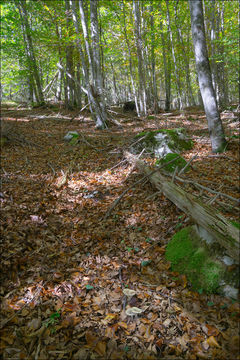Plancia ëd Lactarius blennius (Fr.) Fr. 1838

Descrission:
Slo.: bukova mlenica - syn.: Lactarius viridis (Schrader) Quel. - Habitat: Mixed wood, Fagus sylvatica dominant, Picea abies scattered; slightly inclined mountain slope, southeast aspect; calcareous, colluvial, shallow ground; relatively warm and dry place; partly protected from direct rain by tree canopies; average precipitations ~ 3.000 mm/year, average temperature 6 - 9 deg C, elevation 665 m (2.180 feet), alpine phytogeographical region. Substratum: forest soil, Fagus sylvatica leaf litter. Comments: Lactarius blennius is not showy mushroom. It is of pale, grayish, greenish, brownish colors, which are in addition quite variable. The species is common and keeps with Fagus sylvatica (in mycorrhizal relation) in almost the whole region there this tree thrives. Experts are able to resolve two varieties of this species: Lactarius blennius var. blennius and Lactarius blennius var. fluens. I was unable to assign this find to one of them. Following the key of Section 6 of Lactarius (Ref.: 2, p383) this should be Lactarius blennius var. blennius based on piled dimension (3 - 7 cm for var. blennius contrary to 5 - 12 cm for var. fluens) or Lactarius blennius var. fluens based on strong production of milk (even in quite dry state!). Also variable hut color speaks for this variety. On the other hand, the absence of lighter, almost whitish hut edge speaks in favor of the first option. The only reliable microscopic trait (Ref.:8) - thickness of ixocutis - could not be used because of quite dry fruitbodies. Also, if one reads the description of both varieties in Ref. 9 the text is almost identical and the associated drawings definitely are such. Description of the find: six or seven pilei present in an area of about 4 x 3 m; pilei diameter 4.5 - 7 cm, surface almost dry, only slightly sticky (found after a long period of dry weather) but leaf debris firmly stuck to the hut surface speaking in favor of presence of a distinctive ixocutis; trama and gills of about the same thickness; milk instant, abundant, white, after a longer time, when almost dry, it becomes greenish-gray; gills bruise slowly and mildly darken to brownish, otherwise the fruitbodies do not discolor when handled; stipe 3.5 - 4.6 cm long, 9 to 12 mm in diameter; only minutely sticky; smell mild, pleasant, on fruits(?); taste first mild then distinctly burning but not very strongly; milk has the same taste; SP abundant, light beige with slight yellow tint, oac851. Spores with coarse ridges. Dimensions: (6,5) 7,1 - 8,2 (8,5) x (5,9) 6 - 6,8 (7,1) microns; Q = (1) 1,1 - 1,2 (1,4); N = 35; Me = 7,6 x 6,5 microns; Qe = 1,2; Olympus CH20, NEA 100x/1.25, magnification 1.000 x, oil (spores); in water, spore ornamentation in Melzer, fresh material. AmScope MA500 digital camera. Herbarium: Mycotheca and lichen herbarium (LJU-Li) of Slovenian Forestry Institute, Vena pot 2, Ljubljana, Index Herbariorum LJF Ref.: (1) J. Breitenbach, F. Kraenzlin, Eds., Fungi of Switzerland, Vol.6. Verlag Mykologia (2005), p 50. (2) G.J. Krieglsteiner (Hrsg.), Die Grosspilze Baden-Wrttembergs, Band 2., Ulmer (2000), p 387. (3) M. Bon, Parey's Buch der Pilze, Kosmos (2005), p 86. (4) L. Hagar, Ottova Encyklopedia Hb, Ottova Nakladatelstvi, Praha (2015) (in Slovakian), p 424. (5) R. Lueder, Grundkurs Pilzbestimmung, Quelle & Meyer (2008), p 196. (6) R.M. Daehncke, 1200 Pilze in Farbfotos, AT Verlag (2009), p 958. (7) R. Phillips, Mushrooms, Macmillan (2006), p 56. (8) J. Heilmann-Clausen, A. Verbeken, J. Vesterholt, The genus Lactarius, Fungi of Northern Europe Vol.2. (1998), p 287 S. (9) S. Buczacki, Collins Fungi Guide, Collins (2012), p 288.
Ancludù an coste pàgine-sì:
- Life
- Cellular
- Eukaryota
- Opisthokonta
- Nucletmycea
- Fungi
- Dikarya
- Basidiomycota
- Agaricomycetes
- Russulales
- Russulaceae
- Lactarius
- Lactarius blennius
Costa plancia a compariss an gnun-e colession.
Anformassion an sla sorgiss
- licensa
- cc-by-nc-sa-3.0
- drit d'autor
- 2017 Dr. Amadej Trnkoczy
- fotògraf
- Dr. Amadej Trnkoczy
- original
- archivi ëd mojen original
- visité la sorgiss
- sit compagn
- CalPhotos
- ID


